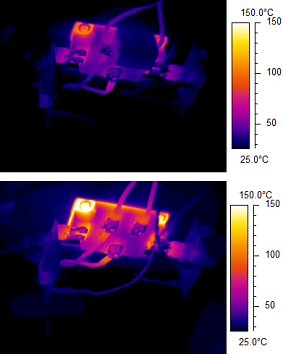Grid-level Power Electronics
Evolution of high voltage Power Electronics is transforming energy and power grid by means of wide-scale interconnection of renewable energy resources, as well as expansion of smart grids for flexible power flow. We investigate and report on latest devices, converters and components used in high voltage applications, such as in transmission and distribution energy networks.

Fault Management
 IGBT/Diode pairs used at the heart of MMC-VSC converters are very vulnerable to high current transients and faults. So, it is critical that all the necessary protections are in place to ensure a cascade failure will not happen, which could be catastrophic from both technical and financial perspectives. To this end, we are working on fault management technologies and novel circuit breaker architectures that will enable a safe operation of converters. For example, we evaluate the impact of recent emergence of Silicon Carbide (SiC) power devices, i.e. thyristors, as protection units for MMC converters and to address the opportunities and challenges introduced by application of these devices.
IGBT/Diode pairs used at the heart of MMC-VSC converters are very vulnerable to high current transients and faults. So, it is critical that all the necessary protections are in place to ensure a cascade failure will not happen, which could be catastrophic from both technical and financial perspectives. To this end, we are working on fault management technologies and novel circuit breaker architectures that will enable a safe operation of converters. For example, we evaluate the impact of recent emergence of Silicon Carbide (SiC) power devices, i.e. thyristors, as protection units for MMC converters and to address the opportunities and challenges introduced by application of these devices.
Reliability Analysis
 The newly emerged wide bandgap semiconductor devices, especially SiC power devices, have advantages which come mainly due to unipolar structure of these devices, enabling high switching rates. However, the combination of such fast switching transients with parasitic inductances in wirebonds and interconnecting passives are the source of electromagnetic strees, i.e. oscillations, in the output terminals of the device. This can have serious implications on reliability and control of the wide-bandgap-enabled power converters. We investigate main roots of such reliability concerns in SiC power modules. Some of these can be categorized as:
The newly emerged wide bandgap semiconductor devices, especially SiC power devices, have advantages which come mainly due to unipolar structure of these devices, enabling high switching rates. However, the combination of such fast switching transients with parasitic inductances in wirebonds and interconnecting passives are the source of electromagnetic strees, i.e. oscillations, in the output terminals of the device. This can have serious implications on reliability and control of the wide-bandgap-enabled power converters. We investigate main roots of such reliability concerns in SiC power modules. Some of these can be categorized as:
Investigation of risk mitigation techniques and their effectiveness along with potential impact on the performance are also amongst our interests.
Converter Topologies
We investigate design of different converter topologies that could be used in grid-level application to enhance performance and reliability of converters. Half-bridge, full-bridge and hybrid converter architectures such as Alternate Arm Converter (AAC) and Series Bridge Converter (SBC) are amongst the topologies under research. These topologies can enable features such as fault blocking capability which would enhance reliability at a low expense compared with installation of DC circuit breakers. Design challenges of bespoke topologies for specialist applications, such as LVDC converters in distribution networks is another area of interest.

Contact
For technical enquiries, please contact Dr Saeed Jahdi.
Industrial Collaborations
We are keen to work with companies to develop technologies that take advantage of opportunities offered by emergence of wide-bangap power devices, especially for grid-level applications to enhance the efficiency and reliability of their solutions.
Further Reading
[1] S. Jahdi and et al., "Temperature and Switching Rate Dependence of Crosstalk in Si-IGBT and SiC Power Modules," in IEEE Transactions on Industrial Electronics, vol. 63, no. 2, pp. 849-863, Feb. 2016.
[2] X. Yuan and et al., "Superjunction MOSFETs in Voltage-Source Three-Level Converters: Experimental Investigation of Dynamic Behavior and Switching Losses," in IEEE Transactions on Power Electronics, vol. 30, no. 12, pp. 6495-6501, Dec. 2015.
[3] B. H. Stark and et al., "Comparison of SOI power device structures in power converters for high-voltage, low-charge electrostatic microgenerators," in IEEE Transactions on Electron Devices, vol. 52, no. 7, pp. 1640-1648, July 2005.
PhD Opportunities
Interested in the electric revolution, future of transport or Power Electronics? We're looking for enthusiastic and motivated students to join the EEMG.
Fully funded PhD scholarships for Chinese students to carry out research at the University of Bristol